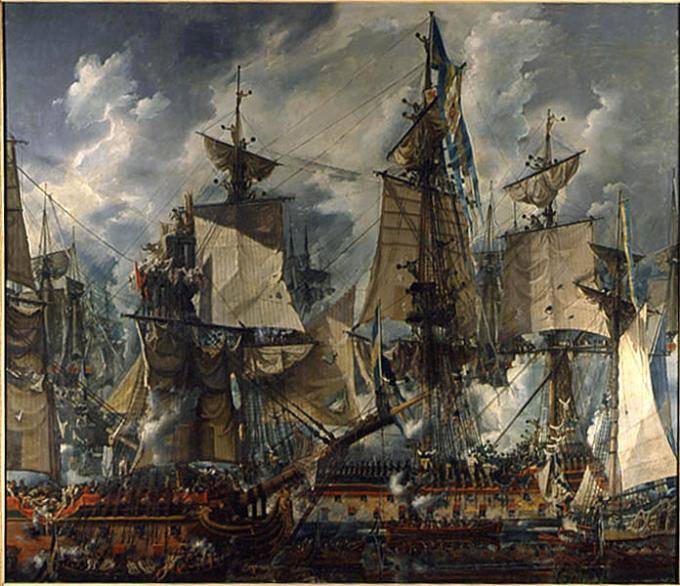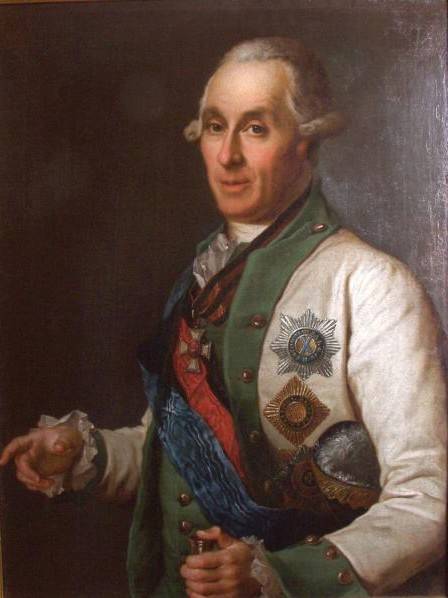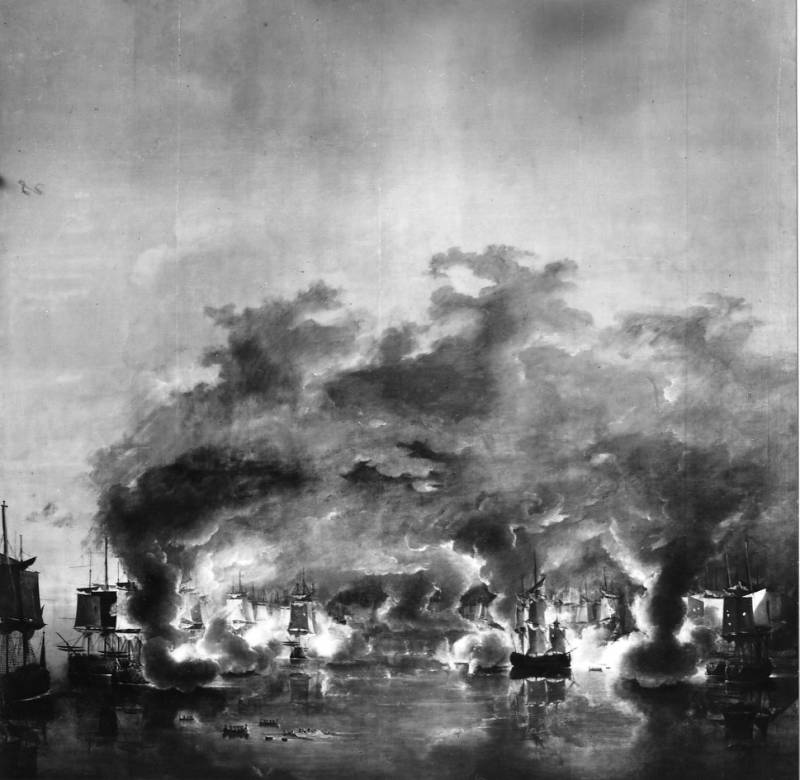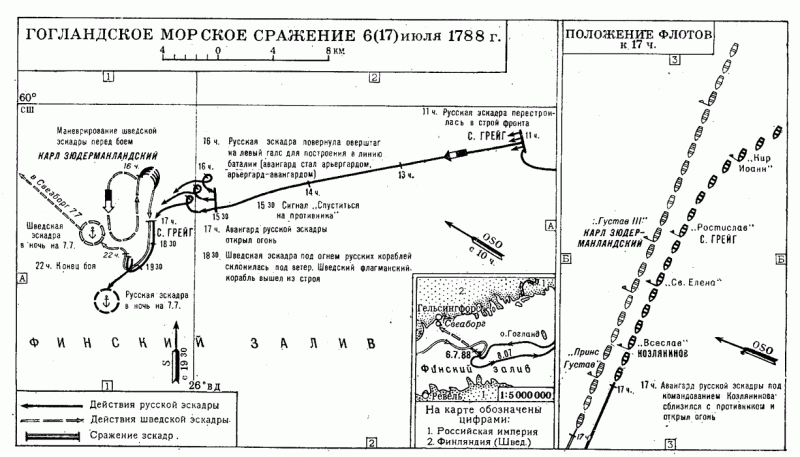Strategic victory of the Russian fleet in the battle of Gogland

230 years ago, on July 17, 1788, the Gogland Sea Battle took place, between Russian and Swedish fleets. Both sides declared themselves winners, although, in essence, the Russian sailors won a strategic victory.
Strategic success remained on the Russian side, since the Swedes were unable to realize their advantage at sea and inflict a decisive defeat on the Russian fleet. This led to the collapse of the Swedish war plan - a sudden and quick strike on an enemy unprepared for war with the subsequent seizure of St. Petersburg.
prehistory
The Swedish king Gustav III decided to return to Sweden the dominance of the Baltic and take revenge for the previous defeat from Russia. The Swedes decided that the favorable moment had come, since the main forces of Russia were diverted to the southern strategic direction - there was a war with Turkey. In addition, significant Russian forces were in the western direction, as there was a threat of war with Prussia. In the northwest, Sweden had superiority in land and sea forces. Sweden in this war was financially supported by France and Turkey. With the beginning of the revolution in France, England also came out as a sponsor of the war against Russia.
Gustav presented to Catherine II an ultimatum: to return the territories of Finland and Karelia, which had ceded to Russia under the Nishtadt and Abossky treaties; return the Crimea to Turkey and conclude peace with Porto through the mediation of Sweden; disarm the Baltic Fleet. That is, the Swedes dictated such conditions as if they had already won a convincing victory. The ultimatum of the Swedes was rejected.
The Swedes were hoping for a blitzkrieg. The decisive role was assigned to the fleet. June 20 Swedish fleet out in the Gulf of Finland. He had the task of a sudden strike to defeat the Russian fleet in a decisive battle and then block and destroy its remnants in Kronstadt. Having achieved dominance at sea, the Swedish command, given the weakness of the troops defending the Russian capital (the main forces of the Russian army were concentrated on the Finnish border), intended to transfer the landing corps from Finland on ships of the galley fleet to Oranienbaum and Krasnaya Gorka. Having quickly moved troops to Petersburg, the Swedes hoped to take the capital and from here dictate the terms of peace to Empress Catherine.
21 June (1 July) 1788, the Swedish army violated the border and attacked the small fortress of Nyslott. The garrison of the fortress was just 230 people. However, throughout the war, the Swedes never managed to take Nyslott. 22 July, the Swedes blocked the fortress Friedrichsgam. The state of the fortress was deplorable. There were no stone bastions, the earthen wall collapsed and collapsed in some places. Fortress artillery consisted of Swedish cannons captured during the 1741-1743 war. The garrison consisted of a 2539 man. The Swedes stood at the fortress for two days, and then retreated. As a result, despite the huge inequality of forces, the Swedes never achieved decisive success, the detachment besieging Nishlot, also forced to retreat. In early August, 1788, the Swedish king with the army retreated from the territory of Russia. Russian Empress Catherine ridiculed this unfortunate attack in the comic opera Gorebogatyr Kosometovich.
The Swedish army retreated, not only because of military setbacks, but also because of internal rebellion. July 24 in the royal army began a mutiny. Many Swedish officers and all Finnish officers did not want to fight. Two Finnish regiments abandoned weapon and went home. In the town of Anjala (Southern Finland), the rebels drew up the “Declaration of the Anyal Confederates” (or the “Conditions of the Finnish Army”), which demanded that the king stop the war with Russia started without agreement with the estates, enter into peace negotiations and return to the constitutional to the government that existed before the absolutist coup. One of the main requirements of the union was the convening of the Riksdag. Part of the officers sought a state department of Finland from Sweden. As a result, the king had to retreat from Russia, but he refused to conclude the world, saying that this would be “suicide” for him.
The Confederates came into contact with the Russian government and declared that they were not involved in the illegal war launched by the king "against national law and their laws." The rebels raised the question of creating an independent Finnish state (obviously, under the auspices of Russia), but Catherine showed no interest in such an idea. Taking advantage of the mess in the Swedish army, the Russian commander Musin-Pushkin proposed crossing the border and attacking the enemy. But Catherine banned offensive operations, hoping that the entire Swedish army would go over to the side of the Confederates. Thus, the fighting on land subsided until the 1789 year. Having not received strong support either in Sweden or in Russia, the Anyal Union collapsed in the fall of 1788, its participants in 1879 were arrested and sentenced to imprisonment. The Swedish king was able to suppress the rebellion, gathered a large militia and strengthened his power, making it almost absolute.
Fleet
The Russian Baltic fleet on paper looked much more powerful than the Swedish: 46 ships against 26. In addition, more 8 ships were in construction. However, most of the ships were in poor condition. Therefore, 10 ships during the war could not even leave the Kronstadt harbor. At best, they could defend the island of Kotlin. Five new ships were in Arkhangelsk, another 5 was built. In addition, when the war with Turkey began, Russia began to prepare a strong squadron in the Baltic to send it to the Mediterranean. As a result, the best ships and frigates of the Baltic Fleet were preparing for a voyage to the Mediterranean Sea, and all maritime activity was directed mainly at the urgent preparation of the Archipelago squadron of S. C. Greig. Scotsman Samuel Karlovich began service in the British fleet, was a resolute and experienced naval commander, took part in the defeat of the Turkish fleet in the Chios and Chesmen naval battles. All ships were sheathed in copper, fully armed and equipped. The main drawback was a large number of recruits in teams. It was believed that during the campaign they will be well trained.
By 27, May 1788, a squadron intended for a voyage to the Mediterranean (including 15 battleships, 6 frigates, 2 bombarding ships, etc.) entered the Kronstadt raid. Three of the most powerful ships of the squadron (100-gun ships Saratov, Three Hierarchs, Chesma), the frigate Nadezhda and 3 of 5 transport were sent to Copenhagen under the command of Vice-Admiral V.P. Fondezin (von desin). Ships with heavy draft could not pass the shallow Zund without first unloading, which required considerable time. The rest of the squadron during this time was supposed to go to Copenhagen and connect with the vanguard. On the way, the fondesin squad met the Swedish fleet, but the Swedes did not dare to attack, they had not yet declared war. 28 June Russian squad arrived in Copenhagen. As a result, there were combat-ready 26 ships in the Gulf of Finland, but some of them required repair.
At the same time, the Swedish king Gustav could wait for the entire Greig squadron to go to the Mediterranean Sea and only then attack Russia. Three powerful ships had already left, and the 15 of the best ships of the fleet were preparing to depart. In this case, in the Baltic, Russia had practically no combat-ready fleet. The Swedish fleet could get an absolute advantage in the forces of the ship fleet. And the Swedes had a better chance of implementing their blitzkrieg. Apparently, Gustav’s haste was due to the fact that Turkey and England paid Sweden a lot of money so that the Russian squadron Greig remained in the Baltic. In addition, the Russian squadron would have left the Baltic only in the autumn, that is, the most favorable time for a strike in 1788 would have been lost. A year later, Turkey could already capitulate and the favorable moment for the start of the war was disappearing. Also, do not dismiss the "artistic" character of the Swedish king. He dreamed of the glory of the great commander and believed in the victory of his fleet.
Simultaneously with the Fonesisin detachment, three frigates Mstislavets, Yaroslavets, and Hector came out of Kronstadt to observe the Swedish fleet at Karlskrona, Sveaborg and the entrance to the Gulf of Bothnia. 44-gun frigate "Mstislavets" 13 June found the enemy fleet, counted the ships and 19 June returned to base. 35-gun frigate "Yaroslavl" 27 June met the Swedish fleet off the island of Surop. Captain A. Bardakov could not leave in time and capitulated. On the same day, the Swedes captured in the Gulf of Finland the 26-gun frigate "Hector" I. Kolokoltseva.
As a result, because of the outbreak of war with the Swedes, the departure of the squadron to the Mediterranean Sea did not take place. For action against the enemy, 5 ships and 2 frigates were prepared in the fastest way. They took literally everyone they could - sailors from small cargo ships, clerks, conspirators from coastal establishments, artisans, recruits, even St. Petersburg prisoners. This detachment under the command of Rear Admiral M.P. Fondezin 25 June arrived at Krasnaya Gorka and joined the squadron Greig. After the start of the war, all transports with troops and cargo intended for shipment to the Archipelago returned to Kronstadt. Greig and his squadron 25 June moved to Red Hill, waiting there for a detachment of Fondezin's detachment in preparation for the march. June 26 Catherine II sent Greig a decree on the withdrawal of the Russian fleet to the sea for action against the Swedish fleet: "Follow with God's help forward, search for the enemy fleet and attack it." 30 June squadron was removed from the anchor and headed west. Due to the lack of wind, the squadron moved slowly and only 5 July circled Gogland from the south.
The forces of the parties
In the morning of 6 (17) on July 1788, the frigate “Hope of Welfare”, sent for reconnaissance, reported to the squadron commander on the approach of the enemy. The fleets met on the western side of the Gogland, between the island of Stenshkher and the shoals of Kalbodegrund. Greig had 17 ships, of which 5 was hastily armed and not having a full crew, made up mostly of recruits, 8 frigates, 2 bombing ships and 5 auxiliary ships. The Swedish fleet under the command of the king’s brother, General-Admiral of the Duke Karl Südermanland, consisted of 17 ships and 7 large frigates with artillery equal in size to the ship, and 5 small (total 1414 guns). Swedish ships were better equipped and had about one and a half months of time for practical training of their crews. That is, the personnel of the Swedish fleet was better trained and prepared.
Greig divided the squadron into 3 units. In the vanguard (when changing the tack, it became the rearguard), it was easier to observe and control the unreliable crews, there was a detachment of M. Fondezin: three 66-gun ships - “Fight”, “Memory of Eustathius”, “Victor”, two 74-gun ships - “Kir Ioann (Fondesin flag), Yaroslav.” In the rearguard (when changing the tack, he became the vanguard), a reliable squadron of T. G. Kozlyaninova was identified: three 66-gun ships - Mecheslav, Vysheslav, Boleslav and two 74-guns - Vseslav (Kozlyaninov flag), "John the Theologian." Greig commanded the Cordebatalia (center): two 66-gun ships - Izyaslav and Rodislav, four 74-gun ships - Vladislav, Mstislav, St. Peter "," St. Elena ”, and 100-gun“ Rostislav ”(flag of Greig).
Battle
In 11 hours Russian squadron lined up in the front. Finding the enemy, the Russian squadron added sails. At the signal of Greig in 15.30, she began to descend on the enemy with a weak wind. Each ship descended on the opposing Swedish, the Rostislav, on the Swedish flagship Gustav III. Greig acted on the canons of linear tactics. The Swedish squadron, while maneuvering, was awaiting the approach of the Russian squadron. In 16 hours she made a turn "all of a sudden" tack on the left tack and lined up in a battle line. At the signal of the flagship, the Russian squadron also turned to the left tack and lined up in a battle, with the 5 ships of Rear Admiral Fonesizin, who were previously in the vanguard, and after the turnaround were in the rearguard, they fell behind and violated the line. Despite Greig's signals, the rearguard is far behind.
The Swedish fleet kept the correct line, keeping equal intervals between the ships. Our fleet maintained a fairly correct system only in the vanguard and the advanced part of the center, followed by 8 ships, mostly from the Fondezin squad, in disarray. The Vseslav ship became the foremost in our line. According to the disposition, he should have been third, but after leaving two ships at the end of the line, who did not understand the signal, Kozlyaninov’s ship became advanced. At around 17, Kozlyaninov’s vanguard got close to the enemy before the 2 cable and, not waiting for a signal, opened fire in response to the fire of the Swedish ships. Following the flagship, all ships, having chosen targets for themselves, opened fire.
Soon most of the ships entered the battle. Russians and Swedes fiercely beat each other at a distance of a shotgun. The fire of the backward rearguard did not reach the goal. Both squadrons strictly adhered to linear tactics. Interestingly, the Swedes commander, Duke Karl Södermanlandsky (future King Charles XIII), spent most of the battle in his cabin, unlike Greig, who on the Rostislav ship attacked the Swedish Prince Gustav under the command of Vice Admiral Gustav Vahmeister. By evening, the Russian sailors noticed some confusion on the advanced Swedish ships. At the same time, the flagship of the enemy, Gustav III, was badly damaged and, with the help of tugs, it was taken off the battle line. After him several more enemy ships left the battlefield. However, during the battle, one of the ships of the Russian squadron - "Vladislav" Captain A. Berha, lost control and was inside the Swedish system. Having not received help from the rearguard ships closest to him, the “Vladislav” fired at the same time with five ships from several sides, with a completely broken hull and spars, a damaged steering wheel, anchors sold, several guns torn from accelerated firing and the people killed around 260 had surrendered. At the same time, the Rostislav, having again come close to the damaged ship Gustav III, forced him to lower the flag. 150 Swedes died on the ship, 400 people were taken prisoner, including Vice Admiral Wahmeister.
The battle continued until nightfall, only after 10 o'clock in the evening the fleets dispersed. At this point, Admiral Greig found out about the capture of "Vladislav", but it was impossible to go to the rescue: many ships were badly damaged, some of them lagged behind. In addition, the sea began to calm. On the morning of July 7 (18), Swedish ships retreated to their port of Sveaborg.
For the fact that at the beginning of the battle they voluntarily turned to another tack, left their places in the line, moved away from the enemy, did not render assistance to "Vladislav" and no longer entered the battle, Admiral Greig removed the commanders of the ships "Fight", "John the Theologian", “The Memory of Eustache” - S. G. Kokovtsev, S. A. Walvert and A. G. Baranov, brought to trial and replaced them with other officers.
Results
As a result of the Hogland battle, the Russian fleet lost more than 500 people killed and more than 600 wounded. The losses of the Swedes, according to their data, amounted to 150 killed and 340 injured (according to other information - about 1150 people). Both sides took one ship with prisoners and declared themselves victorious. Tactically, the battle ended in a draw. However, the Swedish fleet was forced to retreat to its shores and did not gain dominance at sea. The Russian sailors in a stubborn battle destroyed the plans of the Swedish command in one decisive battle to crush the Russian fleet and take Petersburg on the move and thereby end the war in their own favor with one blow. The initiative went to the Russian armed forces. Thus, it was a strategic victory for Russia. This was also noted by Catherine, writing that "the victory was complete."
The Hogland battle was the first full-scale battle of the Russian fleet with heavy use of artillery, that is, a classic battle. The ships of the two fleets received a mass of holes (from 20-30 to 120). The fact that not a single ship was killed was due to the weakness of the artillery caliber of the Swedes and the Russians. So, the maximum caliber of the guns of Swedish ships was 24 or 30 pounds. Carronade was not, brandugues (incendiary nuclei) and bombs were not used.
For the battle of Hogland, Empress Catherine awarded Admiral Greig the highest order of Andrew the First-Called, Rear Admiral Kozlyanin-the Order of St. George, III degree, many captains and officers received orders and golden swords with the inscription "For Bravery."
After Gogland, the initiative passed to the Russian fleet. Seriously damaged, the Swedes were repaired in Sveaborg and hoped that the Russians were doing the same in Kronstadt. The enemy did not expect the Russians to appear soon and was counting on the complete safety of their ships at sea. However, Greig did not justify the calculations of the enemy. Although the ships of our fleet also had significant damage. For example, in the hull of the Rostislav there were up to 120 holes, on Izyaslav and Mstislav there were more than a hundred holes, Kozlyaninov’s ship Vseslav lost the entire spar. But Greig did not go to Kronstadt, and sending four of the most damaged ships there, he corrected the rest of them at Seskar and, without wasting time, moved to Sveaborg.
Quietly, at the entrance to the raid, three Swedish ships and a frigate on a foggy morning on July 26 suddenly saw the leading ships of the Russian fleet. Having cut the ropes, the Swedes hurried to escape to the skerries, and the Gntav Adolf 60-gun ship went aground and was forced to lower the flag. Due to the impossibility of removing it from the bank, he was set on fire and blown up in full view of the enemy. The Swedes, despite the fair wind, did not dare to leave the raid for a new battle with the enemy, and from that time they remained locked in Sveaborg. Greig was in constant readiness with the fleet at Revel and kept strong squadrons of cruisers at Sveaborg and the Gulf of Finland, which carefully watched the exits from the Sveaborg raid, watched the skerries from Sveaborg to Gangut. Russian ships intercepted all ships coming from Sweden with provisions and other supplies necessary for the army and navy. The actions of the Russian fleet created problems with the supply of the Swedish armed forces. Unfortunately, the decisive commander Samuel Karlovich died on October 26 1788 of the year on board his ship Rostislav. This weakened the Russian naval command.

Admiral C. C. Greig in the portrait of an unknown artist


Information